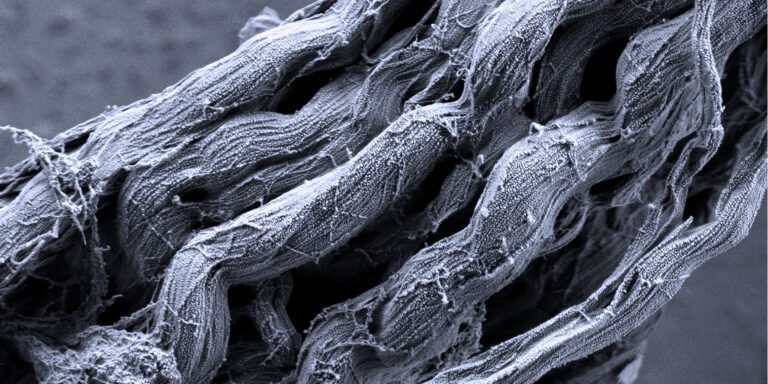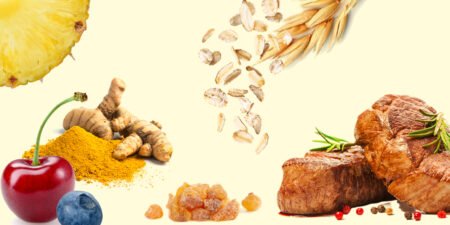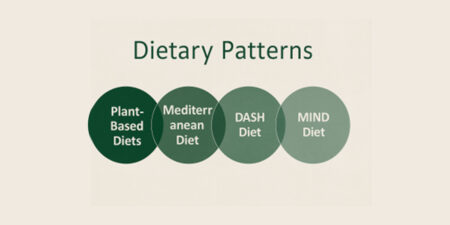Collagens are used in sports for the prevention and treatment of osteoarthritis. They are usually administered in the form of specially developed oral preparations, although their compositions can vary greatly. Certain foods, such as beef, are also rich in collagens.
With regard to the absorption and utilisation of collagen, there are differences and special features to be considered. According to the current state of knowledge, the type of collagen is also decisive for whether the proteins are suitable for the prevention and therapy of osteoarthritis. Collagens are structural proteins that consist of 662–3152 amino acids. The human organism either synthesises collagens itself or they are supplied externally, e.g. through food (meat, fish) or as a dietary supplement (NEM). In the organism, they are hydrolysed to amino acids and peptides, absorbed in the intestinal lumen to a degree that has not yet been clearly determined, successively built up in the organism itself to form collagens and incorporated into collagen-containing body structures. Intervertebral discs, ligaments, tendons, joints and bones are just a few examples of collagen-containing structures in the human body [1].
Depending on the type of sport, certain collagen-containing body structures, such as joints, tendons and bones, are subject to stress, among other things, depending on duration, intensity, posture and type of movement, so that in the long run osteoarthritis can develop. It is considered certain that collagen synthesis decreases with age [1]. Since collagens are proteins that are essential for building and maintaining body structures, the question arises as to what special features athletes should be aware of with regard to collagen synthesis and external collagen intake in order to 1) prevent the development of osteoarthritis and 2) treat existing osteoarthritis with collagen.
Collagen family
There are 28 different types of collagen (collagen I-XXVIII). They can be found in various body structures and fulfil individual functions. It should be noted that the functions of not all collagens have yet been elucidated [1]. What all collagens have in common is that they are structured in a chain-like manner and their structure represents a triple helix. The collagen chains, in turn, consist primarily of three amino acids: glycine, lysine and proline [1]. Like all proteinogenic compounds, collagens are also subject to the mechanisms of protein digestion [2]. Collagens taken orally are consequently hydrolysed in the gastrointestinal tract to amino acids, di- and tripeptides, and reabsorbed by intestinal transporters in the intestinal lumen. The transporters PEPT1, PEPT2, PHT1 and PHT2 located in the intestinal lumen presumably transport oligopeptides, which may have a chain length of up to eight amino acids, to an unknown extent. However, the passage of oligopeptides through the wall of the gastrointestinal tract is a question that cannot be answered with certainty [3, 4]. Absorption through tight junctions, passive diffusion and endocytosis are also discussed as possible uptake pathways [5].
After peptides have crossed the gastrointestinal barrier, they are regularly broken down, e.g. by peptidases [6]. Most peptides from food are subject to low stability and rapid clearance in plasma. However, collagen-associated peptides apparently have a certain resistance in plasma, which offers an explanation for the fact that collagen-associated peptides can be detected in venous blood after oral intake [7–9]. In the target tissue, e.g. in the joint, the required collagens are ultimately built up successively by the body’s own synthesis. This process requires the presence of vitamin C. The water-soluble vitamin is essential for collagen synthesis [10]. Whether and to what extent exogenously ingested collagens are metabolised in the target tissues and develop functions cannot be reliably proven so far.
Osteoarthritis in sports
Osteoarthritis is the most common degenerative joint disease in Germany and worldwide [11]. Advanced age and female gender are among the main unchangeable risk factors. The nutritional status (overweight, obesity) can also be a cause or contributing factor to osteoarthritis [11]. The 12-month prevalence of osteoarthritis in Germany in people over 18 years of age is around 18%, with the proportion of people affected by osteoarthritis from the age of 65 being significantly higher: approximately half of women and a third of men are affected [11]. Athletes seem to be less frequently affected by osteoarthritis overall, although this apparently depends on the type of sport chosen: it has been shown that, among others, former elite athletes from team and racquet sports (e.g. football, handball, tennis) show an increased prevalence of osteoarthritis, whereas endurance athletes (e.g. marathon and cross-country skiers) do not [12–15].
Collagen-rich foods and their benefits for athletes
For athletes, collagens are of interest in the context of osteoarthritis prevention or therapy for a variety of reasons. On the one hand, the body’s own collagen synthesis declines with age, so that the risk of osteoarthritis generally increases. On the other hand, athletes who engage in sports in which the prevalence of osteoarthritis is increased could benefit from collagen intake. It is known that collagens are present in various concentrations in foods of animal origin. Gelatine has the highest collagen content at 84 g/100 g. Gelatine consists largely of purified collagens and, like all collagens found in food, is composed of different collagen types (specifically types I, II and III) [16]. Minced beef contains about 3.6 g collagen per 100 g and sausage about 2.5 g [17]. In lay publications, there are recommendations for athletes that consuming collagen-rich foods can prevent the development of osteoarthritis. So far, there is no scientific evidence or proof for this. Although the mechanisms of protein utilisation apply to food collagens (see the section on the collagen family), However, studies on the effectiveness of collagen in the prevention and therapy of osteoarthritis in athletes are completely lacking. An initial indication that collagens can contribute to the maintenance of cartilage and suppress degeneration processes in cartilage in the case of existing osteoarthritis is provided by an animal study in rats that received collagens from fermented jellyfish [18]. Further studies investigating the effect of collagen-containing foods in the prevention and treatment of osteoarthritis are not currently available. Therefore, at this point in time, no statement can be made as to whether a targeted intake of certain collagen-containing foods has an effect in the context of osteoarthritis.
Collagen-containing food supplements in the prevention and treatment of osteoarthritis
Within the 28 collagen types, type II collagen is usually examined for osteoarthritis, since it is an essential component of cartilage [19]. It is used in the form of food supplements – either as native (undenatured) collagen or as collagen hydrolysate. Collagen hydrolysates are produced by the action of acids and bases, resulting in collagen peptides that can be administered in a targeted manner. The question of whether type II collagen or other collagens contribute to the prevention and treatment of osteoarthritis cannot be answered in a generalised or conclusive way. There are many reasons for this. Producers of NEM use individual compositions of preparations, making it difficult to compare the preparations. Furthermore, the study designs that examine the effect of collagens are often not comparable because they are too different and, ultimately, the results of the investigations also differ. Collagen-containing NEMs achieve positive effects in some studies but not in others. In addition, these are often intervention studies with a small number of participants or different methodologies [20]. However, there seems to be a tendency for preparations with type II collagen to provide some benefit in the treatment of osteoarthritis by alleviating symptoms to a certain extent [19, 21–23]. For example, the results of a randomised placebo-controlled intervention study from 2008 with 147 participants suggest a benefit among athletes. The participants either took 10 g of a collagen hydrolysate or a placebo for 24 weeks. One of the inclusion criteria for participation in the study was that the athletes had to suffer from joint pain associated with osteoarthritis. The evaluation of the study showed that there was a significant reduction in pain in some cases in the intervention group [24].
Conclusion
Collagens are ubiquitous in animal-based foods and are present in varying quantities. Whether collagen-containing foods can contribute to the prevention and treatment of osteoarthritis in athletes cannot be answered due to a lack of data. There is potential for research in this area. Type II collagen, which is administered as a dietary supplement (native or as a hydrolysate), has been initially investigated. The study situation indicates, through cautious positive findings, that corresponding collagen preparations could have a benefit in the case of existing osteoarthritis in reproducible study settings. However, the question of the benefit cannot yet be answered conclusively: researchers worldwide are working to close this gap. From a nutritional-physiological point of view, effective peptide utilisation seems at least conceivable.
Literature
[1] Ricard-Blum, S. (2011). The Collagen Family. Cold Spring Harbor Perspectives in Biology. 3: a004978–a004978.
[2] Goodman, B.E. (2020). Insights into digestion and absorption of major nutrients in humans. Advances in Physiology Education. 34: 44–53.
[3] Khavinson, V.; Linkova, N.; Kozhevnikova, E. et al. (2022). Transport of Biologically Active Ultrashort Peptides Using POT and LAT Carriers. IJMS. 23: 7733.
[4] Killer, M.; Wald, J.; Pieprzyk, J. et al.: Structural snapshots of human PepT1 and PepT2 reveal mechanistic insights into substrate and drug transport across epithelial membranes. Sci Adv; 2021; 7: eabk3259.
[5] Miner-Williams, W.M.; Stevens, B.R.; Moughan, P.J. (2014). Are intact peptides absorbed from the healthy gut in the adult human? Nutr Res Rev 2014; 27: 308–29.
[6] Bagheri Miyab, K.; Alipoor, E.; Vaghardoost, R. et al. (2020). The effect of a hydrolyzed collagen-based supplement on wound healing in patients with burn: A randomized double-blind pilot clinical trial. Burns. 46: 156–63.
[7] Ichikawa, S.; Morifuji, M.; Ohara, H. et al. (2020). Hydroxyproline-containing dipeptides and tripeptides quantified at high concentration in human blood after oral administration of gelatin hydrolysate. International Journal of Food Sciences and Nutrition. 61: 52–60.
[8] Kleinnijenhuis, A.J.; van Holthoon, F.L.; Maathuis, A.J.H. et al. (2020). Non-targeted and targeted analysis of collagen hydrolysates during the course of digestion and absorption. Anal Bioanal Chem. 412: 973–82.
[9] Taga, Y.; Iwasaki, Y.; Tometsuka, C. et al. (2022). Identification of a highly stable bioactive 3-hydroxyproline-containing tripeptide in human blood after collagen hydrolysate ingestion. npj Sci Food 2022; 6: 29.
[10] Brigenlius-Flohé, R.; Kipp, A.P. Wasserlösliche Vitamine. In: Heinrich, P.C.; Müller, M.; Graeve, L.; Koch, H.G. (Hrsg.) (2022). Löffler/Petrides Biochemie und Pathobiochemie. 10., vollständig überarbeitete Auflage. Berlin. Springer Verlag.
[11] Fuchs, J.; Kuhnert, R.; Scheidt-Nave. C. (2017) 12-Monats-Prävalenz von Arthrose in Deutschland. Journal of Health Monitoring 2(3): S. 55–60. DOI 10.17886/RKI-GBE-2017-054.
[12] Kettunen, J.A.; Kujala, U.M.; Kaprio, J. et al. (2001). Lower-Limb Function among Former Elite Male Athletes. The American Journal of Sports Medicine. 29(1): S. 2-8. doi:10.1177/03635465010290010801.
[13] Michaëlsson, K.; Byberg, L.; Ahlbom, A. et al. (2011). Risk of severe knee and hip osteoarthritis in relation to level of physical exercise: a prospective cohort study of long-distance skiers in Sweden. PLoS One. 30;6(3):e18339. doi: 10.1371/journal.pone.0018339.
[14] Cassel, M.; Krickhahn, A.; Krause, P. et al. (2017). Bewegung und Arthrose. In: Banzer, W. (Hrsg.) Körperliche Aktivität und Gesundheit. Berlin. Springer Verlag. S. 289-296.
[15] Schmitt, H.; Rohs, C.; Schneider, S. et al. (2006). Führt intensiver Langstreckenlauf zur Arthrose der Hüft- oder Kniegelenke? Orthopäde 10(35): S. 1087-1092.
[16] Naomi R, Bahari H, Ridzuan PM, et al. (2021). Natural-Based Biomaterial for Skin Wound Healing (Gelatin vs. Collagen): Expert Review. Polymers (Basel). 13(14):2319.
[17] Rimbach, G.; Nagursky, J.; Erbersdobler, H.F. (2015). Lebensmittel-Warenkunde für Einsteiger. 2. Auflage. Berlin – Heidelberg. Springer Verlag.
[18] Sudirman, S.; Chen, C.Y.; Chen, C.K. et al. (2023). Fermented jellyfish (Rhopilema esculentum) collagen enhances antioxidant activity and cartilage protection on surgically induced osteoarthritis in obese rats. Front Pharmacol. 30;14:1117893. doi: 10.3389/fphar.2023.1117893.
[19] Wang, H. (2021). A Review of the Effects of Collagen Treatmant in Clinical Studies. Polymers (Basel) 13(22): 3868. Doi 10.3390/polym13223868.
[20] García-Coronado, J.M.; Martínez-Olvera, L.; Elizondo-Omaña, R.E. et al. (2019). Effect of collagen supplementation on osteoarthritis symptoms: a meta-analysis of randomized placebo-controlled trials. Int Orthop. 43(3). S. 531-538. doi: 10.1007/s00264-018-4211-5.
[21] Lugo, J.P.; Saiyed, Z.M.; Lane, N.E. (2016). Efficacy and tolerability of an undenatured type II collagen supplement in modulating knee osteoarthritis symptoms: a multicenter randomized, double-blind, placebo-controlled study. Nutr J.,15:14. doi: 10.1186/s12937-016-0130-8.
[22] Sadigursky, D.; Magnavita, V.F.S.; Sá, C.K.C. et al. (2022). Udnatured Collagen Type II For The Treatement Of Osteoarthritis Of The Knee. Acta Ortop Bras. 30(2):e240572. doi: 10.1590/1413-785220223002240572.
[23] Luo, C.; Su, W.; Song, Y. et al. (2022). Efficacy and safety of native type II collagen in modulating knee osteoarthritis symptoms: a randomised, double-blind, placebo-controlled trial. J Exp Orthop. 9(1):123. doi: 10.1186/s40634-022-00559-8.
[24] Clark, K.L.; Sebastianelli, W.; Flechsenhar, K.R. et al. (2008). 24-Week study on the use of collagen hydrolysate as a dietary supplement in athletes with activity-related joint pain. Curr Med Res Opin. 2008 May;24(5):1485-96. doi: 10.1185/030079908×291967.
Autoren
ist Professorin für Ernährungswissenschaften und Leiterin des Studiengangs Ernährungsmanagement an der APOLLON Hochschule der Gesundheitswirtschaft in Bremen. Sie ist zudem zertifizierte, qualifizierte Diät- und Ernährungsberaterin und Autorin zahlreicher Bücher. Ihre Schwerpunkte sind Essstörungen, Nahrungsmittelunverträglichen und -allergien, rheumatische Erkrankungen und Tibetische Medizin.
ist wissenschaftlicher Mitarbeiter für Ernährungswissenschaften und Studiengangkoordinator des Studienganges „B.Sc. Ernährungsmanagement“ an der APOLLON Hochschule der Gesundheitswirtschaft. Sein Interesse gilt der wissenschaftlichen Bewertung von Ernährungstrends und Prävention von lebensstilbezogenen Erkrankungen.





